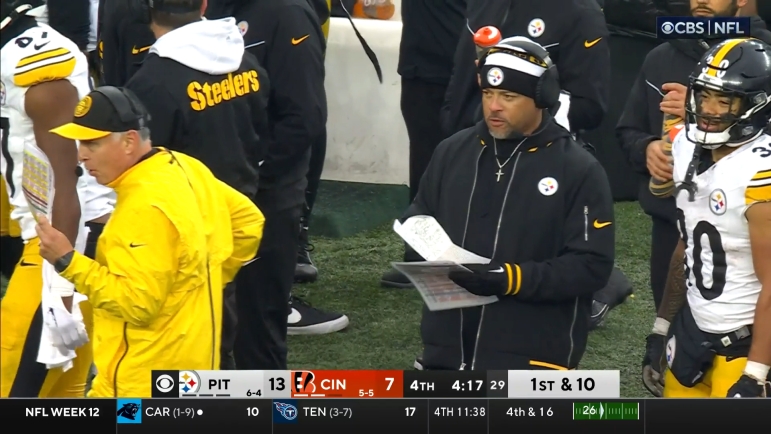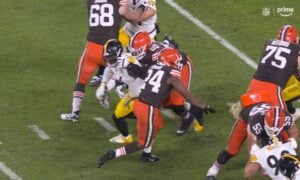Before the ball is snapped, before the offense even lines up, there can already be chaos. And it sets a bad omen for everything that happens afterward. Each play is called into QB Kenny Pickett’s helmet by a coach, then Matt Canada and now Mike Sullivan. There’s an art to it. Give him the info he needs and nothing more and do it in a timely manner. Take too long to decide, mangle the call, or try to overload the quarterback with information, and you’re beating yourself before the defense has to do anything.
For all the subtle changes Sullivan and interim OC Eddie Faulkner made in last Sunday’s win over the Cincinnati Bengals, perhaps their biggest was just the speed of which the play call came in.
Speaking to reporters during his Thursday session, Faulkner said part of the feedback he received of the new-look roles of himself and Sullivan was simply the players hearing the call sooner than before.
“I heard some of the guys in their comments say the play is coming in quicker,” Faulkner told reporters via a team-provided transcript when asked what Sullivan did differently.
Crisp, clear communication. That’s the goal. Especially for teams like the Steelers, who call in the play as opposed to having a quarterback work off his wristband. A coaching staff can either verbalize the call or say a play number, which the quarterback then reads off his wristband in the huddle.
For those who choose the former, there’s a right and wrong way to simply call the play. A few weeks ago, Peyton and Eli Manning demonstrated it. On their Peyton and Eli Monday night watch-along, Eli played offensive coordinator and play caller while Manning got back out on the “field.”
The “right” way is to quickly and clearly call the play. The “wrong” way is to consistently chime in with additional information, which just muddies the communication process and overloads with information. You can see examples of both here.
Now, we don’t know if that was an issue with Canada. And communication does get shut down with 15 seconds on the play clock (or at least, the coach will hear a loud and annoying tone, as Kevin O’Connell experienced trying to coach along Josh Dobbs).
Either way, it sounds like Sullivan is feeding info quicker and more efficiently. That allows the offense to break the huddle sooner, not feeling as rushed or unable to make checks and adjustments at the line of scrimmage. Just like the actual rhythm of an offense, a group that works at a constant speed and in nots fits and spurts, breaking the huddle should be basic and consistent.
It’s certainly not the only reason why the Steelers’ offense was better last Sunday. But with a clearer plan and a veteran like Sullivan feeding the information, the offense seems to be spinning at a higher RPM even before Pickett steps to the line of scrimmage.








